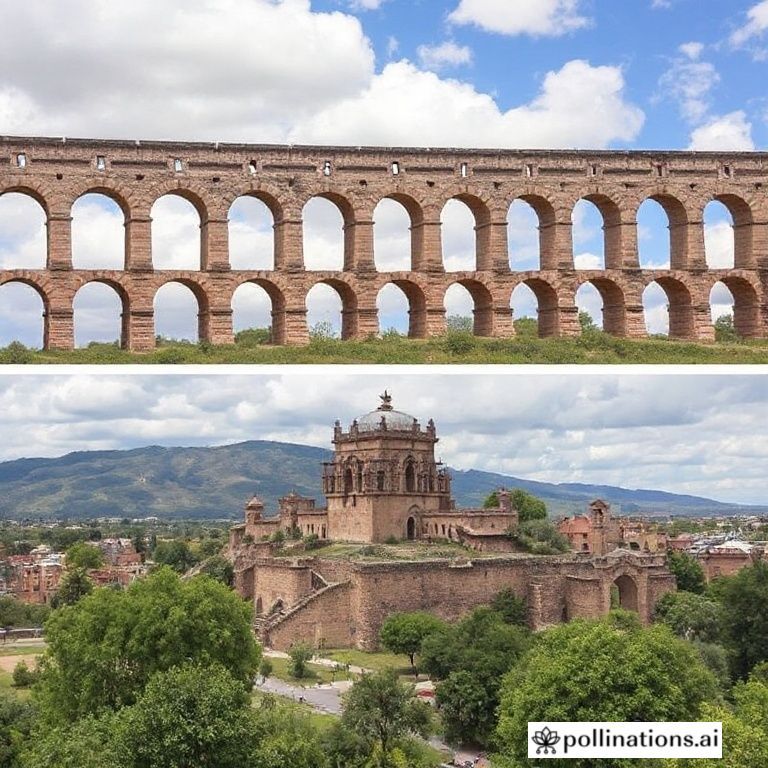Morelia, the capital city of Michoacán, Mexico, is a captivating destination that seamlessly blends history, culture, and architectural grandeur. Known as the “Pink Stone City” due to the distinctive pink cantera stone used in its buildings, Morelia boasts a stunning UNESCO World Heritage-listed historic center. Among its many impressive landmarks, the Morelia Aqueduct stands as a testament to the city’s rich past and engineering prowess.
Join us as we delve into the enchanting world of Morelia, exploring its iconic pink stone architecture, the magnificent aqueduct, and the vibrant cultural scene that makes this city a must-visit destination in Mexico.
Discovering Morelia’s Pink Stone Heritage
The first glimpse of Morelia’s historic center is sure to leave a lasting impression. The city’s architectural landscape is defined by the use of pink cantera stone, a volcanic rock that lends a warm, rosy hue to its buildings. This unique aesthetic is a defining characteristic of Morelia and contributes significantly to its charm. The pink stone is quarried locally, a tradition passed down through generations of artisans. This beautiful stone was favored during the colonial era and continues to be used in construction and restoration projects today, preserving the city’s unique identity.
Notable Pink Stone Structures
- Morelia Cathedral: A masterpiece of Baroque architecture, the cathedral is the most iconic landmark in Morelia. Its twin towers soar above the city skyline and its intricate facade showcases the exquisite craftsmanship of the era.
- Government Palace: Located on the Plaza de Armas, the Government Palace is another example of the city’s stunning pink stone architecture. Inside, murals depict the history of Michoacán and Mexico.
- Clavijero Palace: This former Jesuit college now serves as a cultural center and houses temporary exhibitions, concerts, and other events. Its elegant courtyard and arcades are a delight to explore.
The Grand Aqueduct: A Symbol of Morelia
The Morelia Aqueduct is one of the city’s most impressive historical landmarks. Built in the 18th century to provide the city with a reliable source of fresh water, this architectural marvel stretches for over a kilometer and features 253 arches. Constructed of the signature pink cantera stone, the aqueduct is a testament to the ingenuity and engineering skills of the colonial era. It’s hard to believe that this imposing structure was built without modern machinery, relying solely on the labor of skilled artisans and the strength of animals.
A Stroll Along the Aqueduct
Today, the Morelia Aqueduct is a beloved symbol of the city. A stroll along the pedestrian walkway that runs parallel to the aqueduct is a popular activity for both locals and tourists. The walk offers stunning views of the structure itself, as well as the surrounding cityscape. The best time to experience the aqueduct is during the golden hour, when the setting sun casts a warm glow on the pink stone, creating a truly magical atmosphere.
Legends and Lore
Like many historical landmarks, the Morelia Aqueduct is surrounded by local legends and folklore. One popular tale tells of a wealthy landowner who commissioned the aqueduct to impress a beautiful woman. While the truth behind this story remains a mystery, it adds a touch of romance and intrigue to the aqueduct’s already captivating history.
Exploring Morelia’s Cultural Treasures
Beyond its architectural wonders, Morelia offers a vibrant cultural scene. The city is home to numerous museums, art galleries, and theaters. Visitors can immerse themselves in the history of Michoacán at the Museo Regional Michoacano, or explore contemporary art at the Centro Cultural Clavijero. The city also hosts a variety of festivals and events throughout the year, celebrating everything from music and dance to food and film.
Must-See Cultural Attractions
- Conservatorio de las Rosas: This renowned music conservatory is one of the oldest in the Americas and hosts regular concerts and recitals.
- Callejón del Romance: This narrow alley is a romantic spot adorned with poetry and flowers, perfect for a leisurely stroll.
- Mercado de Dulces: Indulge your sweet tooth at this traditional candy market, where you can sample a variety of local treats.
Conclusion
Morelia, the Pink Stone City, is a treasure trove of history, architecture, and culture. From the stunning Morelia Aqueduct to the charming streets of its historic center, this city offers a truly unforgettable experience. Whether you’re a history buff, an architecture enthusiast, or simply seeking a beautiful and authentic Mexican destination, Morelia is sure to captivate your heart and leave you with lasting memories.
If you enjoyed this article, don’t forget to explore more inspiring stories on Life in Mexico!
IMAGE: A wide-angle shot of the Morelia Aqueduct at sunset. The aqueduct stretches into the distance, its pink stone arches illuminated by the warm golden light. The sky is a mix of orange, pink, and purple hues. In the foreground, there are lush green trees and flowering bushes. The mood is peaceful and serene, capturing the beauty and historical significance of the landmark. Style: Naturalistic, high-resolution photography.


